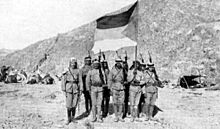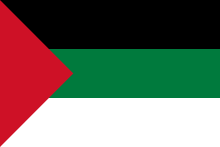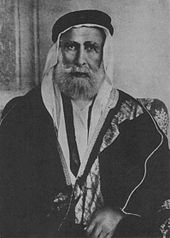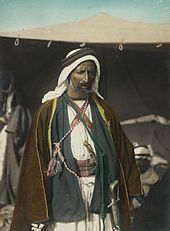Arab Revolt
![]()
The title of this article is ambiguous. For other meanings, see Arab Revolt (disambiguation).
The Arab Revolt was an uprising in the Ottoman Empire carried by some Arab tribes, which started in Hejaz and later spread to Jordan, Palestine and Syria. The revolt, which lasted from 1916 to 1918, was significantly supported by the Entente, which was fighting against the Ottoman Empire in the First World War. The revolt was led by Hussein ibn Ali, the sheriff of Mecca. Numerous, but not all, Bedouin tribes of Hejjah participated in the revolt. Gradually, the Bedouins took control of more and more towns in Hijaz, as well as in Jordan and Syria. The revolt ended with the conquest of Damascus and the surrender of Medina.
Nevertheless, considering the totality of the fighting in the Middle Eastern theater of war, the British army bore the brunt of the fighting, while the insurgents were largely limited to sabotage and minor raids. Although the Hussein-McMahon correspondence had previously promised the sheikh rule over all of Arabia, after the war the victorious powers, France and Britain, divided the conquered territories among themselves, with the exception of the Hejaz. This was legitimized by mandates of the League of Nations. After the Arabs had thus initially been excluded from government, the British gradually installed representatives of the Hashemite dynasty as emirs or kings in their mandated territories.
The British secret agent T. E. Lawrence - who was sent as a liaison to the insurgents - became famous as "Lawrence of Arabia". However, the role attributed to him during the uprising is highly controversial.

Soldiers of the Arab Army during the Arab Revolt

Flag of the Arab Revolt - it serves as a model for numerous national flags of later Arab countries.
Previous story
Even before the war, there were sometimes strong tensions and subsequently repeated clashes between the Bedouins living in the Hedjas and the Turks. The subject of these disputes was in most cases the Hedjaz Railway leading from Damascus to Medina, which was completed in 1908. Many Bedouins objected to the construction of this railway because they perceived it as competition to the caravans. Furthermore, many Bedouins feared that the construction of the railway would deprive them of the opportunity to raid other caravans. For these reasons, the railway was repeatedly sabotaged by small Bedouin troops and the workers were prevented from building it. However, the Bedouins usually did not get involved in battles with the Ottoman army.
In the years 1908 to 1909, the resistance against the Hedjaz Railway reached a temporary peak, as more and more tribes took part in the sabotage actions and even engaged in smaller skirmishes with the Ottoman army. This action against the Hedjaz Railway was tolerated by the Hashemite sheriff of Mecca, Hussein ibn Ali, but not officially supported. Over time, the rebellion subsided again, as the Bedouins were poorly armed and thus had no realistic chance against the regular Turkish troops.
In 1915, after the outbreak of the First World War, Hussein learned that the Turks were already planning his deposition after the end of the war. For this reason, he decided to support the British in their fight against the Ottoman army and thus maintain his power and extend it to the entire Arab region. The latter were themselves on the defensive after the defeat at Kut al Amara, so Hussein's support was more than welcome to them.
On April 15, 1915, the Sirdar Reginald Wingate was commissioned by the Foreign Office to make contact with the Sherif of Mecca. Eventually, an exchange of letters took place between Hussein and the British High Commissioner to Egypt Sir Henry McMahon, which has gone down in history as the Hussein-McMahon correspondence. In it, the Sherif was promised all the Arab provinces of the Ottoman Empire, with the exception of the Syrian Mediterranean coast. A little later, on May 16, 1916, France and Great Britain decided in the Sykes-Picot Agreement to divide the Ottoman provinces into French and British spheres of influence.
When Hussein finally learned in early 1916 that Turkish troops were to march through Hijaz, he panicked and officially opened the Arab revolt on June 5, 1916.

The Grand Sheikh of Mecca Hussein ibn Ali
History
The Arab forces were led by Hussein's sons Abdallah (later Emir and King of Jordan) and Faisal (later King of Syria and Iraq respectively) and supported by military advisors such as T. E. Lawrence (called "Lawrence of Arabia"). Their task was to facilitate the fight on the Palestine front for the British Expeditionary Force in Egypt, composed mainly of colonial troops, under the command of Archibald Murray (from 1917 Edmund Allenby) by actions in the rear.
On June 5, 1916, Arab irregulars opened the fighting of the Arab Revolt with skirmishes against the Ottoman garrison in Medina. The skirmishes served to keep the garrison under Umar Fachr ud-Din Pasha and its 11,000 soldiers in Medina busy. Faisal opened the actual main attack with a symbolic rifle shot at the Turkish garrison in Mecca. The 1,400 or so men of the Turkish garrison were quickly overwhelmed and the insurgents managed to bring the city under their control within three days. An Ottoman artillery fort held out until July 9, 1916. Turkish troops from the fort bombarded the city several times a day until then. Simultaneous with the attack on Mecca, an assault by 4,000 irregulars on the coastal city of Jeddah took place on June 10, 1916. The Ottoman garrison was initially able to repel the attack with machine gun fire and artillery, but surrendered on 16 June after being attacked by two British warships and British aircraft. Similarly, on June 10, Arab irregulars under the command of Faisal's son Abdullah began cutting off the lines of communication and traffic to Taif. The troops there under the governor of Hejaz Ghali Pasha surrendered on September 21, 1916. By the end of September, the insurgents still took control of the Red Sea coastal towns of Rabigh and Yanbu. By this time, the insurgents had captured about 6000 members of the Ottoman army. In November, Faisal declared himself king of the Arab lands. His British allies, however, only accepted his claim to rule over the Hejaz.
On August 1, 1916, Sharif Ali Haidar arrived in Medina to replace the Ottoman rebel Faisal after his defeat. In the autumn of 1916, Fahri Pasha launched a counterattack against the Arab rebels. The British authorities considered sending their own troops because of the guerrillas' inferiority against the Ottomans, but after consulting with T.E. Lawrence, they sent only Arab volunteers and pushed for the gift of funds to Faisal so that he could recruit more locals. By December 1916, 950 Egyptian artillerymen and about 120 volunteers had reached Faisal's armies. By December 11, Ottoman forces had pushed Faisal's army of 5000 men there back to Yanbu, which blocked the route to Mecca on the coastal route. The appearance of five British warships, which were to support the defence of the harbour town with their on-board artillery, induced Fahri Pasha to refrain from an attack. After repeated aerial bombardments of positions in front of Yanbu, the Ottoman troops retreated towards Medina. Supported logistically and with artillery fire by British warships, a rebel army of some 11,000 men attacked Wagh on 23 January 1917 and took the town in a two-day battle. The place served as a base for guerrilla attacks against the railway line in the Hijas.
On May 9, 1917, Lawrence set out with the sheriff Nasir and a few men on a journey along the Nefud Desert to Maʿan in order to recruit more warriors for sabotage operations in the vicinity and eventually for the capture of Akaba. On their journey, they were soon joined by Auda ibu Tayi, a tribal chief of the Howeitat. With his help, they finally succeeded in defeating the Turks off Aqaba at Abu l-Lisan on July 1. Thus the Arabs were able to take Aqaba without a fight on July 6. The city now played a major role in the further course of the revolt, as supplies could be embarked there. Thus the Bedouins were enabled to carry the Arab Revolt into Palestine and Syria. Thus Aqaba was used to carry out several acts of sabotage against the Hedjaz Railway and telegraph poles. On 8 October, the British Expeditionary Force succeeded in breaking through at Gaza and advancing further north through Palestine.
On September 19, 1918, a decisive battle between the Turks and the British took place near Amman. In order to relieve the British front, T. E. Lawrence was given the task of carrying out some sabotage operations with the Bedouin warriors near Darʿā. For example, on September 16, 1918, the insurgents attacked a bridge near Darʿā. However, these were later forced to retreat by Turkish aircraft. Eventually, however, Lawrence managed to obtain some planes for reinforcement, which is why the Arabs were finally able to continue the siege of Dar'a.
After opening the offensive on September 19, Allenby already captured Amman on September 24. Now the Turks were forced to retreat first to Dar'a and finally to Damascus, so that the Arabs were able to take Dar'a without a fight as early as September 27. Subsequently, they repeatedly attacked the Turkish retreat with extreme brutality, possibly complicating the reorganization of the Turkish army. A little later, on September 30, the Turks also abandoned Damascus in order to save the remaining troops for the defense of Anatolia. Now the Bedouins endeavored to reach Damascus before the British, in order to emphasize their own participation in the war and thus to obtain a share in the administration of the conquered territories. On October 1, they finally entered Damascus, ending the Arab Revolt.

Auda ibu Tayi

T. E. Lawrence ("Lawrence of Arabia") near Rabegh, north of Jeddah, 1917
Search within the encyclopedia